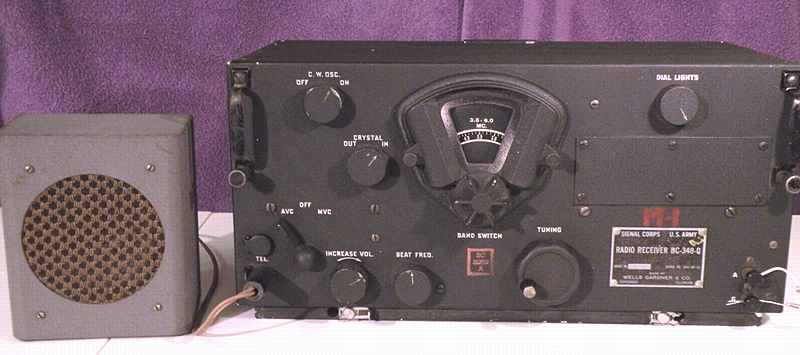
Signal Corps BC-348Q receiver
The Signal Corps BC-348Q is a WW II vintage U S Army Air Corps receiver with a VLF band covering 200 to 500 KHz and five HF bands covering 1.5 to 18.5 MHz. The manual for the BC-348Q and its J and N brothers can be found on several websites including BAMA. See the links on the home page for PDF copies. Here is a link to another BC-348Q I acquired some years ago .
The BC-348 was used as the long-distance liaison receiver for large aircraft such as bombers in World War II and the early 1950's.

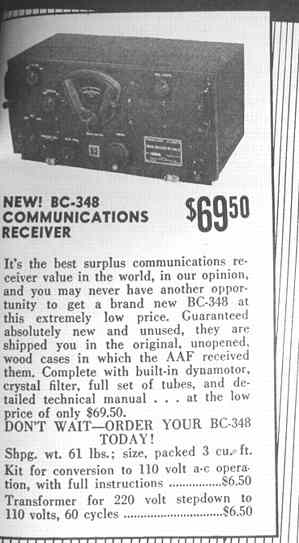
These are single conversion superhets with an IF frequency of 915 KHz. All of the BC-348 models featured switchable AVC or manual RF gain, a beat frequency oscillator, a crystal filter, 2 stages of RF and 3 stages of IF amplification. This example is a model "Q" of the J,N,Q family manufactured by Wells-Gardner.
With that many stages, one would expect these to be very capable shortwave receivers. Most existing BC-348 examples were purchased as military surplus and modified by hams (amateur radio operators) so they could be run on 115 volts AC.
These ads for the surplus BC-348 are from the November 1947 QST (left) and the January 1949 CQ magazines (below).
Note the price increase with inflation and demand in the two ads 14 months apart.

Articles on a variety of modifications appear in QST, CQ and other magazines beginning in 1947 to mid 1959 and beyond.
This BC-348Q was modified with an AC power supply. The removable dynamotor chassis (back left in the chassis picture below) was modified to accept a power transformer, a filter choke, 6X5 rectifier tube and a couple of electrolytic filter caps. The power switch and fuse were rewired to control AC power. The tube filaments and the dial lights were rewired in parallel for 6 volts from the transformer.
An original BC-348 has no ventilation openings. The design and the temperatures in an unpressurized aircraft at typical operating altitudes were apparently such that very little ventilation was needed. Although designed for use with headphones, it provides plenty of volume if used with an efficient speaker and the proper matching transformer.
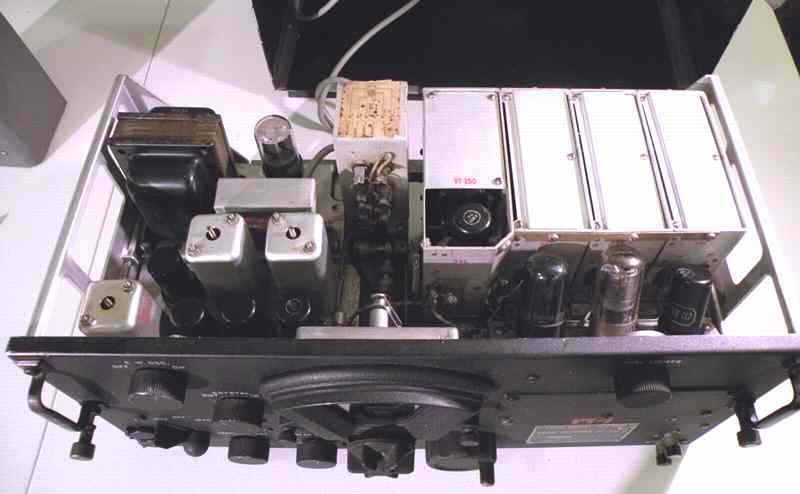
Repairs
According to the nomenclature plate, this receiver was part of "Order NO. 2541-WF-42" as serial number 1435. It was purchased at a ham radio swap meet. The BFO control was missing but the prior owner had thoughtfully tied a baggie with the knob and a couple of parts to the radio. The front panel was in very good cosmetic condition with no modifications. The back of the cabinet has a series of ventilation holes added.
Since the transformer power supply was homebrew, the first thing I did was check on the quality and safety of the work. I traced the power switch wiring and found that the fuse had been bypassed with a piece of wire. One of two electrolytic capacitors had a bare wire on the B+ side uncomfortably close to the chassis. I removed both electrolytics. After testing the power transformer, I determined that its high voltage was too high for the set. I rewired the power supply for choke input and installed a new electrolytic capacitor. I replaced the power cord with a safer three-wire grounded cord, rewired the fuse connections, installed a proper fuse, and disconnected the AC from the BC-348's original eight blade power connector. I tested several of the metal enclosed capacitors used in the set and to my surprise found them to be in good order. After repairing the power supply, I connected an external speaker with a proper 4000 ohm matching transformer and slowly powered the set while monitoring B+ voltage and current draw, keeping the variac throttled back a bit because of the still somewhat excessive B+. Surprisingly, the set worked well on shortwave broadcasts.
CW Oscillator on-off switch and the missing BFO control
The "Beat Frequency" Oscillator coil was badly bruised and other parts were missing. However, the "CW Oscillator" on-off switch was stuck in the "On" position. Contact cleaner did not solve the problem. I removed and opened the actual switch and was then able to repair it.I tried repairing the original BFO coil with a generic donor slug and control body. No luck. The coil had proper continuity and the bruised top section was OK when tested for a proper level of "Q" but the smaller inside section had near zero "Q" leading me to conclude it had a shorted turn. There was no indication of oscillation on the scope. I next tried a small variable capacitor and a generic AM broadcast oscillator coil using the BC-348's original fixed mica caps. I was delighted when my scope showed the oscillator working although, not surprisingly, at too high a frequency. I temporarily added a fixed cap between the plate feed and ground to bring the oscillator frequency down to the required 915 KHz. The variable cap was about 60 pf at full mesh. The cap could be tuned through a range of about 20 KHz above and below the 915 KHz target. The manual mentioned the original BFO had a range of about 4 KHz plus or minus the target. I experimented with a small trimmer cap in series with the variable cap to reduce the range to that value. By experimentation, another small fixed cap was selected to replace the temporary parallel cap so that the 915 KHz was still in the center of the variable cap range. The result worked quite well. I spent some time listening to 80 meter SSB. I could see why the radio was popular with hams of the 1950s and 60s.
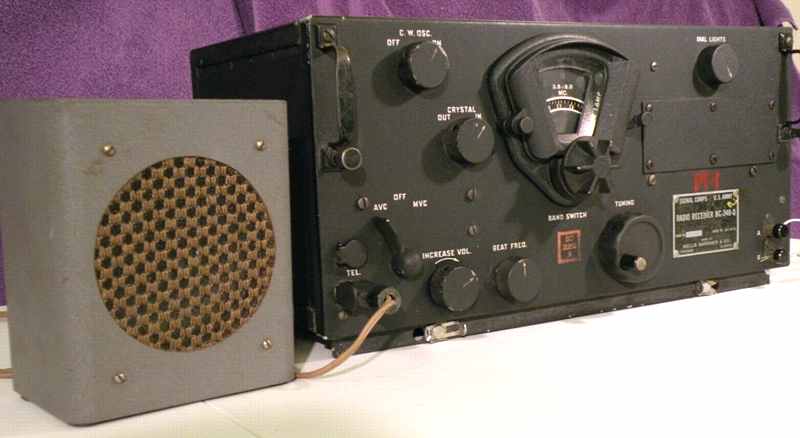
Reducing excess B+ and distortion
I was told that the radio should be operated at or near its design high voltage of 228 volts. From the schematic, it is obvious that the B- is not tied to the chassis in a BC-348. The chassis is actually at 18 volts relative to B- and 210 volts relative to B+. The 18 volts to chassis provides a source of bias for the 6K6 final audio tube. A description in the manuals for several other models of the BC-348 mentions that the 6K6 audio output tube also helps with voltage regulation and is biased to draw a bit more current at higher voltages to keep the B+ voltage from the dynamotor in a relatively narrow range. The B+ for this modified set measured about 260 volts. I experimented with adding resistors in the B+ line. I found that reducing the voltage to the design maximum also reduced the maximum audio level slightly. However, in comparing the audio quality between the design B+ voltage and the higher voltage, I noticed that the higher voltage introduced noticeable distortion to the audio. I added a terminal strip and 720 ohm resistance for a final B+ that was very close to the design voltage.
I debated replacing the 6X5 with solid state diodes and adding some more series resistance. This could easily be done with a pair of 1N4007 diodes in a tube base and would therefore be a reversible decision. I may do that in the future. However, the tube rectifier did not seem to be causing any problems with excessive heat. I like the slow power up for B+ afforded by the 6X5 so for now I decided to leave well-enough alone.
BC-348 listening to SSB in the 80 meter ham band.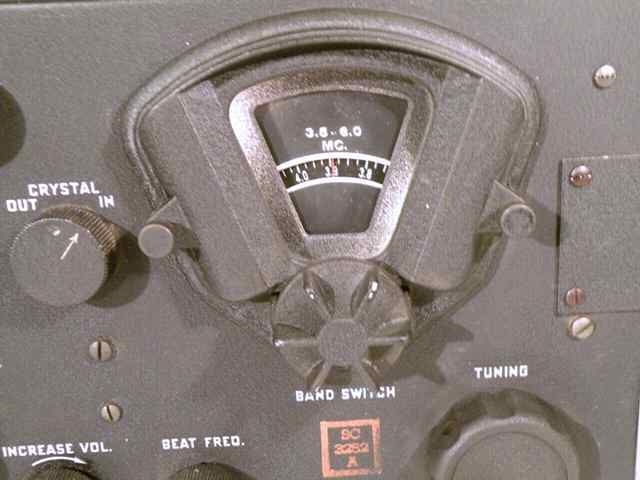
More information
For nice pictures of a BC-348Q chassis with a dynamotor still in place, see the folowing web page by Ralph W5JGV .
For information on the history of the BC-348Q and related models, see the article by Ken KF6NUR at this link .
Here is a picture of the BC-348 and related components installed on a B-29. .
The Hewlett-Packard HP-200A audio oscillator, HP's first product, was the previous item on the bench.